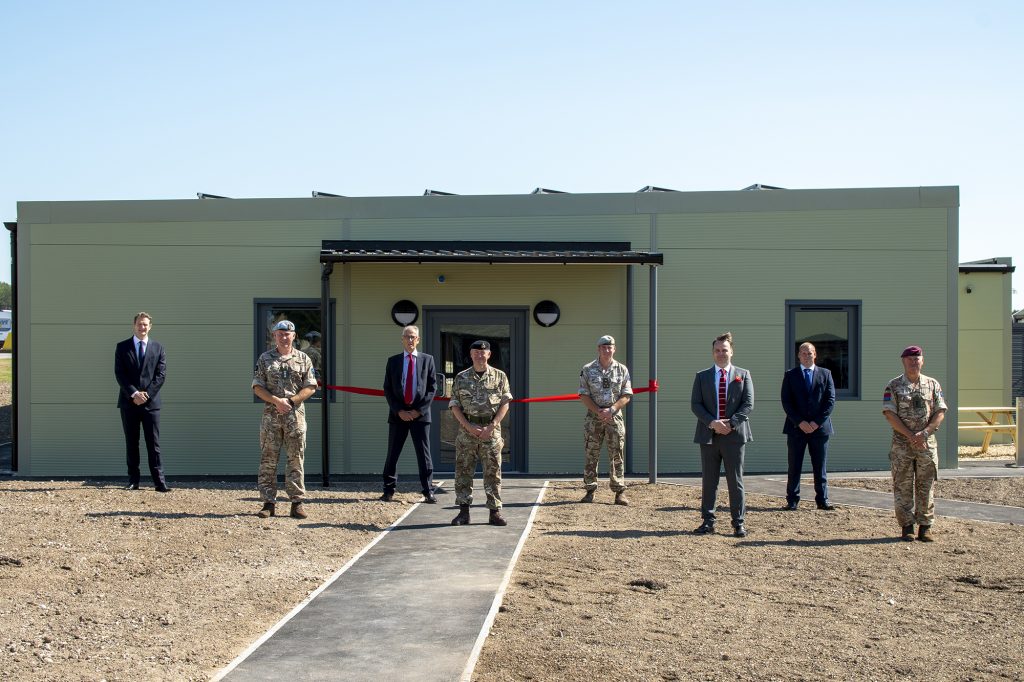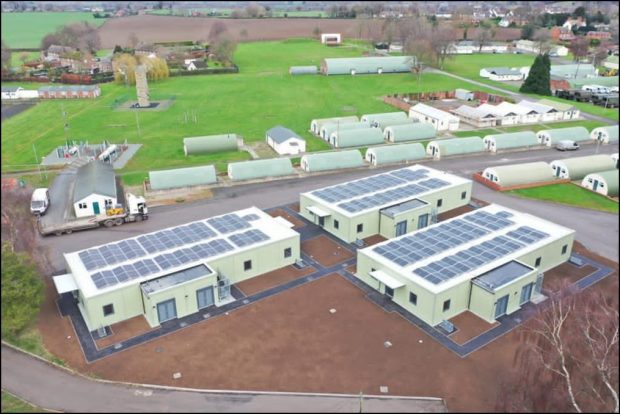
The programme is being part-funded using money from a £200m investment to improve Armed Forces accommodation, which was announced by the Defence Secretary last summer. We are investing over £35 million of this funding, in addition to funding from the British Army, into this nationwide programme which aims to improve facilities for troops when they are training away from their permanent barracks. They might only be staying there for a matter of days or a couple of weeks, but comfortable, modern accommodation can make a real difference.
The remainder of the £200 million investment is being spent on Service Family Accommodation, training accommodation at Longmoor Training Camp, and improvements to Single Living Accommodation across Army, Royal Air Force and Royal Navy sites.
A carbon efficient building
Working with our industry partner Landmarc Support Services and contractor Reds10, we are installing 38 new carbon efficient accommodation blocks across the UK Defence Training Estate, which will provide more than 1,700 bed spaces.
Westdown Camp on Salisbury Plain was the first to receive a new carbon efficient accommodation block, with high-tech features such as air source pumps and rooftop solar panels providing the building’s heating and hot water requirements. Its A-rated Energy Performance Certificate (EPC) was further improved on for three new accommodation blocks at the second site, Nesscliff Training Area in Shropshire, which have an EPC rating of -5. This means they actually generate power for the site, reducing electricity costs.
Benefits of modular construction
All accommodation is being designed and constructed off-site by modular building specialists Reds10, before being transported to the site for assembly and installation.
The manufacture and installation process for the new accommodation block at Westdown Camp took just 15 weeks, and the team was then able to use the experience gained to complete all three buildings at Nesscliff in 13 weeks.

A major benefit of modular construction is that it allows the same design to be re-used, but with the ability to make changes and improvements. This meant that Reds10 were able to build on some of the initial successes of the first accommodation block at Westdown Camp, with the subsequent buildings at Nesscliff achieving net zero and a 30% reduction of embodied carbon compared to Westdown Camp.
Over the next year or so, we’ll see very similar buildings being installed on a number of other sites, including Castlemartin Training Area in Pembrokeshire, Warcop in Northumbria, Knook Training Camp on Salisbury Plain, Brunswick Camp in Hampshire, and West Tofts and Wretham on Stanford Training Area in Norfolk.
This is a big project for us and it’s fantastic that this investment is allowing us to do something which will make a real positive change for personnel training on our sites.
5 comments
Comment by Sandy Blackburn posted on
Great to see we are starting to think green employing passiv building techniques in the military... Military bases offer some of the best opportunities for exploiting renewable energy... in particular solar and anaerobic digestors, as they are often located next to open farm land ( AD) and they offer vast flat light exposed sites with plenty of roof space for retrofit. The incentives are aimed at RHI at the moment... we need to get better at harnessing heat energy but it doesn't travel well... these are ideal sites for this as it keeps the producing of energy and the using of the energy together! Well done... you need to bring me in on this to help!
Comment by DIO Communications Team posted on
Thanks Sandy! We do have an AD facility powering RAF Marham in Norfolk - more details here: https://insidedio.blog.gov.uk/2019/02/18/the-power-of-green-energy-enough-electricity-to-run-raf-marham/
Comment by Sandy Blackburn posted on
Absolutely as I envisaged it! Great news...being ex-RAF and still in a military environment you'd think I would have known!! There we go... every day's a learning day!! Great news... It makes so much sense!! I want to be part of this team...
Comment by Roofer seo posted on
really informative posts
Comment by Chris Edwards posted on
So we’ve got modern solar panels on top of buildings etc in camps but unable to recruit troops to occupy them, 1 in 3 soldiers already serving want to leave the army, aircraft carriers that break down so wouldn’t get to a conflict on time and trident nuclear deterrent launched from subs that continually misfires, As long as net zero is on track at any cost it doesn’t matter though.